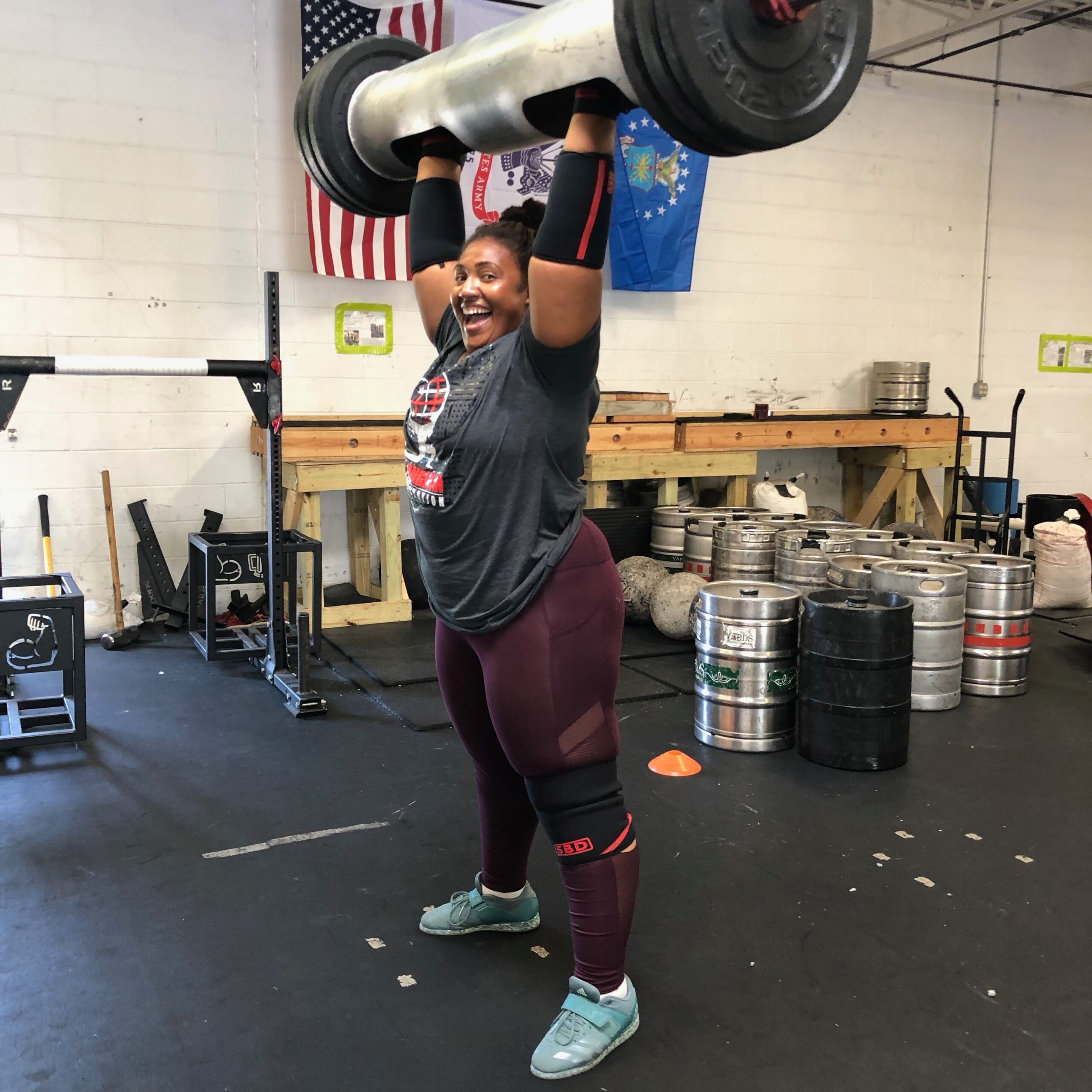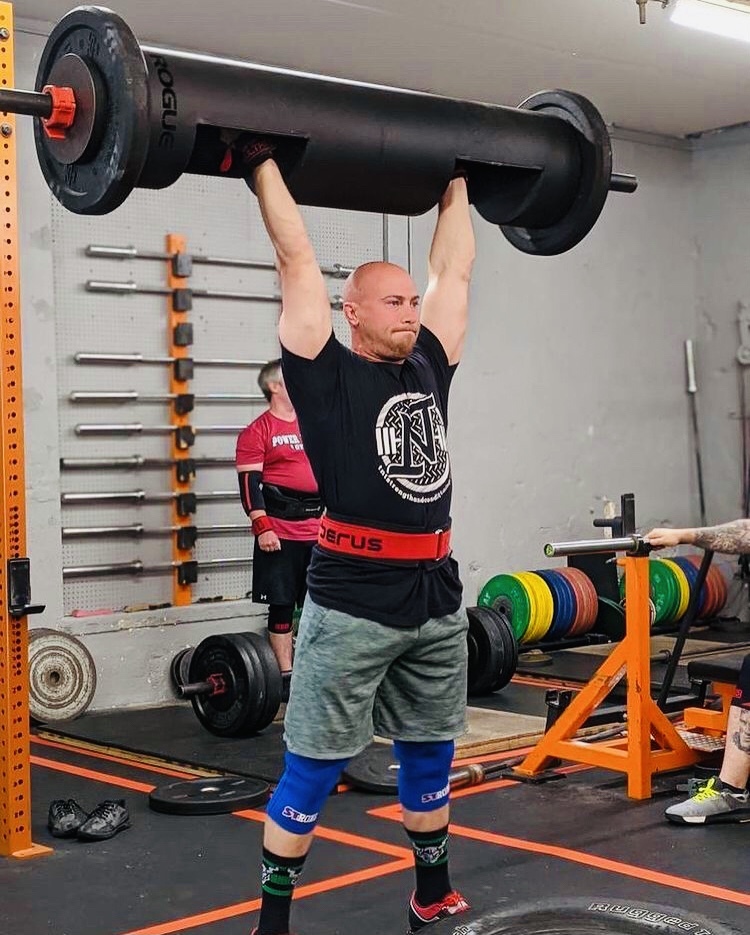
The log press is among the most iconic strongman events. It shows up at the very highest levels and at the smallest local shows. It’s also one of the most challenging implements to program for because it’s a technical lift with lots of components.
In this article we’ll cover how to effectively program for log press, including:
- Breaking down and understanding the complete movement
- Specific lifts and drills to use in training each piece of the movement
- Addressing common faults with helpful cues and long-term programming fixes
We’ve also included a sample week of log-specific programming that you can implement for yourself or your athletes right away.
Breaking Down the Log Press Movement
The 2 primary phases of the log clean and press are – as the name suggests – the clean and the press. Each piece can be further broken down as follows…
Clean: Step-by-Step
- Pick: The clean starts with a pick from the floor or mats. This should be treated like a deadlift with straight arms and primarily using legs to move the weight. For most athletes most of the time, handles should face forward.
- Lap: After the log clears the knees, the athlete will sit with the log resting on the thighs and chest (generally) wrapped around the log to set up for the clean. Lap position will vary from athlete to athlete and depends on the technique used for the clean. As a general rule the log should be pulled tight to the body with a strong upper back.
- Clean: The athlete moves the log from the lap to the shoulders (or to overhead if using a viper technique). This is the most dynamic, explosive, and technical part of the lift. It’s also the most challenging piece for most athletes.
- Rack: At the top of the clean and before the press, the log will sit in the “rack” position on the athlete’s shoulders. Lower back and core should be tight and stable. Upper back is generally extended to accommodate the size/shape of the implement. This position requires a huge amount of strength, stability, and body awareness to set up for a successful press.
Press: Step-by-Step
- Rack: A solid press starts with a rock solid rack position. Handles forward, elbows and lats locked in, full body braced.
- Dip/Drive: In order to press the log overhead, most athletes must generate power from the lower body. While maintaining a tight rack position, the athlete will bend the knees slightly and lower hips, then aggressively explode upward to drive the log off the shoulders. This is the most critical part of the press and also the most likely piece to fall apart at heavier loads and under fatigue.
- Press: This is the end of the lift when the log is pressed/locked out overhead. A good reps is called when the implement is under control with elbows locked out, knees and hips open, and feet in a straight line (i.e. recovered from any split-related movements). Logs can be pressed any way the athlete wants: strict press, push press, power jerk, or split jerk. The athlete may also use a viper press, which bypasses the rack position and goes directly from the lap to overhead.
Training Each Piece of the Movement
Pick
You don’t generally need anything too specific here in terms of training because compared to other deadlift weights this should be reasonably light. Anything you’re already doing to train picks from the floor will carry over nicely here. The only additional thing to think about is that the handles are a neutral grip, so training with a Swiss/football/multi-grip bar (or other neutral grip object) can be helpful here.
Lap
Same deal as the pick – nothing too fancy here. The most important part is figuring out the best position for the individual athlete to set up for a solid clean. Stronger front squatters will benefit from keeping the log high on the chest and treating the clean more like a squat. Stronger hip drivers will want to keep hips higher and treat this more like a stone by wrapping the upper torso around the log.
Clean
The 2 biggest factors here are upper back strength and hip drive. Upper back strength keeps the log close to the body and in the correct position through the movement. Hip drive is what ultimately gets the implement from the lap to the rack.
Great choices for upper back strength specific to log cleans include: rows with a Swiss/multi-grip bar, tempo rows with a pause at the top and slow eccentric, chest-supported rows with iso hold at the top, or really any row to be honest. Keep the focus on building time under tension and excellent scapular control to train keeping the log in tight.
Solid options for training hip drive specific to log cleans include: For the power piece try heavy Russian kettlebell swings, hang power cleans, hang clean high pulls, and box jumps (great as an activation drill). For the strength piece work with heavy hinging movements that train the glutes and hamstrings, such as barbell hip thrusts or heavy good mornings.
For more advanced lifters: Training viper press is a great way to work on snappy cleans because the lifter will have to generate lots of power to get the log from the lap all the way overhead (instead of just to the rack position). Viper presses are also a nice way to build some volume at lighter weights and can be used on a light/technique/power day if training log movements more than once per week.
Rack
Stability and tension are the name of the game here. Maintaining a solid rack position requires body awareness because it’s an awkward position. We like to coach it by thinking about the lower back and upper back separately. Lower back stays braced and relatively flat/straight. Upper back (thoracic spine) extends/leans back to get the center of mass on the log as close as possible to the lifter’s midline.

This position requires enormous strength – and mental comfort – in an extended position, so training the muscles in the posterior chain is important. We like heavy good mornings (especially with a safety squat bar) and back hypers/extensions on a 45° bench or GHD (add weight or a band for bonus work here).
Lat and upper back strength is also key to a strong rack position. Elbow position will vary from athlete-to-athlete, but it’s super important to be able to keep the elbows in a consistent position for the dip/drive portion of the lift (see below). This requires support and engagement from the lats, so plug in all your usual suspects for lat training here (pull-downs, push-downs, pull-ups, etc).
Just holding the log in the rack position is also really helpful. You can incorporate this a couple ways. The simplest is by adding a timed hold at the end of working sets to build time under tension in that position. Another option is to add timed holds out of a rack or from blocks. This option allows the lifter to significantly overload the movement, which is helpful both physically (for muscles and CNS) and mentally (to get used to having heavy weight in a pretty uncomfortable and potentially scary position).
Dip/Drive
The 2 most challenging parts of this phase for most lifts are keeping a tight/stable rack position while dipping/driving, and keeping weight in the heels and midline (and not tipping forward). Achieving effective positioning and control requires stability above the waist, power below the waist, and awareness of the body in space.
For stability above the waist, focus on all the things discussed above for strength to maintain a solid rack position.
For below the waist, strength and explosiveness is key. Focus on foundational strength (squat, leg press, etc) and power movements that require lots of quads, glutes, and hip extension (like box jumps).
To train positioning in the dip and drive, try incorporating jerk dips and/or jerk drives at the end of a log session. (These can be incorporated with or replace rack holds for efficiency.) As an activation drill and to build body awareness, try wall jerk dips before doing log presses. Another option is to add a pause in the dip position before pressing. This allows the lifter to build strength in that position and make any adjustments to the position before pressing.
Press
The lift isn’t over until you lock it out overhead, so the actual press is pretty important. Training methods for this will vary depending on pressing style used. If going with a more technical lift – like power jerks or split jerks – it’s often helpful to learn these movements with a barbell or axle first because they’re much easier to navigate.
To decide where to focus energy, you’ll need to first identify where the lifter struggles the most: strength, timing, stability, position, or power transfer.
To work on strength: More presses! The actual log press itself is only a piece of the puzzle. Incorporate barbell presses and lots of shoulder accessory volume. Bonus points if you can use a neutral grip with a Swiss/multi-grip bar or dumbbells.
Log strict presses are also a useful tool. Here’s a great video on how and why to do them by MST Systems (this whole series is great if you want to deep dive): https://www.youtube.com/watch?v=3fL71MU7KJg. You can also substitute a Swiss bar here because it’s usually easier to set up and achieves a similar result.
Triceps are important because they assist in the last portion of the lockout. Incorporate higher volume triceps (like push-downs or dumbbell extensions) in hypertrophy cycles and heavier movements like Tate extensions, heavy push-downs, or dips/weighted dips in strength-focused cycles.
To work on timing: It’s hard to learn timing with heavy weights, so drills with a PVC or light/moderate weight barbell or axle are helpful here. We like jerk balance, tall jerks, and just loads of reps focusing only on footwork and timing. Once comfortable with the barbell/axle, move on to empty log work and slowly add weight from there.
To work on stability: Overhead holds and marches work really well here. You can add a timed hold or counted march (holding the log/implement locked out overhead) to the end of any set. You can also overload this movement by setting up in a power rack or with safety arms and starting with arms already locked out then standing up from there (like a very high partial overhead squat).
Jerk recoveries are a useful tool for both stability and position, and can be used to train for split jerks (like in the video) or power jerks. These can be done with the log, a barbell/axle, or – for added stability challenge – with weights hanging by bands from the ends of the implement.
Accessory movements can also be very helpful here. Anything that works on scapular control and shoulder packing is useful. Our favorites are: bottom-up kettlebell press, dumbbell Z-press, pizza z-press, L-lateral or 90/90 dumbbell raise, and YTIs. Remember that the small supporting muscles (like those in the rotator cuff) are just as important as the big ones.
To work on position: Pretty much all the things above will help with this, especially the footwork and timing drills and overhead stability work. This is less about strength and more about muscle memory and body awareness. Video reviews can also be really helpful here because athletes aren’t always able to feel what they’re doing, so seeing it can be super useful.
To work on power transfer: Jerk drives are functional here, and it’s often helpful to work on this with a more technique-friendly implement like a barbell or axle. It’s also worth noting that you’ll have to determine if the lack of power transfer is more related to a technical issue (like not understanding the concept or timing), or a strength issue (i.e. not having the actual strength or power to drive the weight high enough off the shoulders for a successful press).
Cueing Log Press and Things to Look for as a Coach
When coaching, we have to think about cues and training and how those 2 things interact. (For a deeper dive on cueing and training, check out this post: ____). A cue is something you can say or demo quickly in the moment that triggers an athlete to make a specific adjustment. Training is a longer explanation and the time spent building a foundation that responds to good cueing. For example, you can yell “heels!” at a lifter all day, but if you’ve never taken the time to explain what that means, why it’s important, and how to do it… it’s useless.
Below we’ll go through some common movement faults, helpful in-the-moment cues to use, and long-term solutions to work on in training.
Problem: using arms to place the bar in the lap at the start of the clean
Cues: “keep arms long,” “stand and then sit,” “deadlift it first”
Long-Term Solution: practice just the pick off the floor and transition to lap without any other part of the lift so the athlete can focus on one thing at a time
Problem: using arms/biceps to curl the log to the shoulders instead of using hip drive
Cues: “use your hips,” “pop it up there” (thinking about a “pop” versus a “roll” can be helpful), “quick elbows”
Long-Term Solution: isolate the movement from lap to rack, train powerful hip extension movements (as discussed above), make connections to similar movements if the athlete is good at them (like stone loading – log clean is more similar to a stone load than a barbell clean)
Problem: log sliding down the chest in the clean
Cues: “pull it in tight”
Long-Term Solution: train upper back strength (especially with neutral grip), video so the athlete can see what’s happening
Problem: elbows dropping in the dip phase of the dip/drive
Cues: “eyes up,” “elbows up,” tighten lats
Long-Term Solution: jerk dips, jerk drives, rack holds
Problem: shifting weight into toes (instead of heels) on the dip/drive
Cues: “stay in your heels,” “eyes up,” “knees out”
Long-Term Solution: wall jerk dip warmup, pauses in the dip with lighter weights, jerk dips and jerk drives
Problem: Jerk timing is off, resulting in a press-out
Cues: “drop under” or “drop hips down” (if the lifter isn’t doing that), “bend your knees in the catch,” “drive and drop,” or remembering that elbows should lock out at the same time that feet hit the ground again
Long-term Solution: drill jerk technique with lighter weights and/or more forgiving implements using the recommended drills above
Problem: losing the log in front or not pushing head through quickly enough
Cues: “push back on it” (meaning when it gets overhead), “look up – look forward” (this helps to cue the transition from looking up when the log is in the rack to punching head through and looking forward while pressing overhead), “push your head through”
Long-Term Solution: jerk position drills (jerk balance or tall jerk in particular), practice with an axle first
Sample Week of Log-Specific Training
This is not a complete program – it’s only the log-related portion. It would work best for a lifter training 4+ days per week with 2 days of overhead work, and could be used in conjunction with other training movements the same day.
Day 1 – Light/Power/Technique
Activation/Movement Prep:
- Wall Jerk Dip: 1×10
- Box Jumps: 3×3-5 @ moderate height
Primary Log-Related Movement:
- EMOM: 6×1 @ 50-60% of max weight… use viper press if working on hip drive, or pause between clean and press to work on overhead technique
Assistance Work:
- Log Overhead March: 3 x 20-30 sec @ EMOM weight
- Dumbbell Z-Press: 3×10
Day 2 – Heavy/Strength/Competition Standards
Activation/Movement Prep:
- Russian KB swing: 3×8 @ moderate weight
Primary Log-Related Movement:
- work to a conservative 2-rep max
- drop to 80% of that max for an additional 2×3
Assistance Work:
- Rack holds: 3 x 10-15 seconds @ 105% of 1RM clean & press
- Swiss bar Pendlay row: 3×8 @ RPE 8
COMING SOON: Full 12-Week Log-Specific Training Program
We have a full 12-week log-specific training program in the works. The goal is to give you something you can use immediately for yourself or your clients that fits seamlessly into any standard strongman program. Check back soon for availability!
More InfoIf you’d like more personalized guidance, you can reach out for a free 15-min coaching call or to set up a longer consult by emailing katiefeeleystrength@gmail.com.



